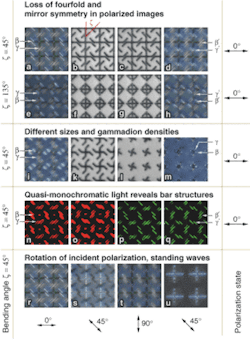A collaboration led by researchers at the University of Southampton (Southampton, England) has demonstrated that a two-dimensionally patterned nonmagnetic metamaterial can produce effects that are not time invariant. In experiments, polarized light was found to produce different far-field patterns when reflecting from flat structures whose only difference was the "handedness" of the patterns etched onto them (the direction in which they were twisted). The results were not mirror images of each other and the difference between them was found to be sensitive to changes in the incoming polarization. After ruling out other possible sources of asymmetry, the team believes its evidence of broken time-reversal symmetry is unambiguous.
The time-invariance of optics (the fact that the system works the same way for light propagation in either direction) is something that most of us take for granted. However, given that electromagnetic fields have a known handedness, there is no reason in principle why this should be the case. In fact, though it has been shown theoretically that certain molecules with two- and three-dimensional chirality can break this symmetry, no one has been able prove it experimentally.
Recently, Nikolay Zheludev and his team have demonstrated the effect for what they believe is the first time, and have done it in such a way that it is apparent simply by looking through a microscope. The structures they used consisted of a 100-nm layer of gold sandwiched between two 20-nm titanium films. The gold was patterned with an array of so-called gammadions, which look like crosses with a single kink bisecting each arm. Where internal angles of the arms are positive, the shapes are considered to be clockwise, and vice versa for negative internal angles. Etching was performed using direct electron-beam writing and ion-beam milling. The pitch of the gratings was 4 µm in both directions, with a 1-mm2 area available for optical measurements.
Explaining the asymmetry
Initial results with monochromatic light showed that symmetry-breaking was indeed taking place.1 The most striking results, however, have been with white light (see figure).2 Here, the difference in the effects of the left- and right-handed structures was clear not only in the fact that the pattern shapes were different, but that they were differently colored. Though material-dependent (removing the top titanium layer lessens the effect, and replacing the gold with chromium makes it undetectable), the symmetry-breaking does not seem to be sensitive to the size of the shapes used. What makes the most difference is the incoming polarization of light. This is crucial because it explains what causes the asymmetry in the first place.
The researchers have a model of what is going on based on the excitation of surface plasmons (SPs) and standing waves in the grooves of the structure. The component of arriving light that is polarized parallel to the groove, he says, is not coupled into the SP and thus is simply reflected. The perpendicularly polarized component, on the other hand, excites SP polaritons in the groove. The interaction is strongly dependent on the size of the grooves, the materials used, and the frequency of the light, which together produce polarization conversion and colors. The symmetry-breaking effects that are not fully explained by this model, he says, come from the nonlocality of the optical response: in other words, from the combined excitation of the entire gammadion structure, not just individual points or segments.
To ensure that the effect they were seeing was real, and not an artifact of the experiment, the team made efforts to rule out other causes. In particular, says Zheludev, they do not believe any sort of aperture effect could have caused the effect because the same features are seen in the image regardless of magnification. Grating pitch and density have also been ruled out as possible sources of the polarized image symmetry (described in terms of magnetic symmetry), as have imperfections in the polarizers.
Zheludev says that the peculiarities of light scattering from their planar chiral structures have similarities to those of so-called anyons: hypothetical quasi-particles discussed in theories related to trapped electrons and superconductivity, but in this case are relevant to photons trapped in the structure. Indeed, he says, they may constitute the first observation of electromagnetic anyons.
REFERENCES
- A. Popakostas et al., Phys. Rev. Lett. 90 (10), 107404 (March 14, 2003).
- A. S. Schwanecke et al., Phys. Rev. Lett. 91 (24), 24704 (Dec. 12, 2003).
About the Author
Sunny Bains
Contributing Editor
Sunny Bains is a contributing editor for Laser Focus World and a technical journalist based in London, England.

